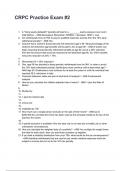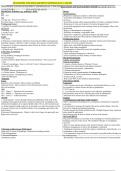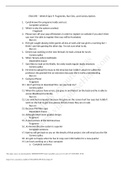CRPC Practice Exam #2
1. A "rising equity glidepath" typically will lead to a ________ equity exposure over one's
total lifetime. - ANS-Decreased. Remember: RISING = decrease. HIGH = Low.
2. Are withdrawals from an IRA to pay for qualified expenses exempt from the 10% early
withdrawal penalty? - ANS-Yes.
3. Assume that a worker's Social Security full retirement age is 66. What percentage of the
worker's full retirement age benefits will be paid to her at age 62? - ANS-A worker can
begin receiving Social Security retirement benefits at age 62, but at a 25% reduction
from the full amount that would be received at full retirement age 66. So 100% benefits
minus the reduction of 25% = 75%.
4.
5. Remember 62 = 25% reduction!
6. Dan, age 58 has decided to being periodic withdrawals from his IRA. In order to avoid
the 10% early withdrawal penalty, distributions must continue until at least what age? -
ANS-Age 63. Distributions must continue for at least five years or until the individual has
reached 59.5, whichever is later.
7. Financial statement ratios are part of what kind of analysis? - ANS-Fundamental
analysis.
8. How do you calculate the inflation-adjusted rate of return? - ANS-1 plus the Rate of
Return
9.
10. Divided by
11.
12. 1 plus the interest rate
13.
14. minus one
15.
16. multiplied by 100
17. How much can a single person exclude on the sale of their home? - ANS-Up to
$250,000.00, provided the home has been used as the principal residence for two of the
previous five years.
18.
19. A partial exclusion is available if the two year rule is not met due to health, job or other
unforeseen circumstances.
20. How you calculate the weighted beta of a portfolio? - ANS-You multiply the weight times
the beta for each stock, then you add those numbers up together.
21. If you take a hardship distribution from your TSA, what would be the tax consequences?
- ANS-Hardship withdrawals that are used to pay certain medical expenses would be
subject to income tax but not to the 10% tax penalty.
, 22. In order to be considered a "qualified" policy, a long-term care policy must provide for
what? - ANS-Nonforfeiture options, cognitive impairment must be covered, it must be
guaranteed renewable and conform to the National Association of Insurance
Commissioners Model Act.
23. Intestate property passes by means of what? - ANS-The probate process. It is NOT a
will substitute. Property that passes by the laws of intestate succession is not affected y
any will provisions. Intestate succession statues give property to many other family
members before transferring it to the state.
24. Moving averages, graphs and statistics regarding the supply and demand of stocks are
an example of what kind of analysis? - ANS-Technical analysis.
25. Name a few things that Medicare Part A covers. Hint: Remember; Part AH! HAhspital! -
ANS-Post-hospital home health care - 100 home health care visits per benefit period and
expenses such as in patient hospital care, post hospital skilled nursing care, post
hospital home health care, psychiatric hospital care and blood in excess of three pints.
26. Name a few things that Medicare Supplemental Insurance (Part B) provides coverage
for. - ANS-Provides coverage for physicians services and the following that are not
already covered by Part A: Home health care, medical services, therapist, ambulances
and certain costs for blood that are no covered in Part A
27. Net short-term capital gains are treated as what type of income? - ANS-Ordinary. They
are subject to the taxpayers regular marginal tax rate.
28. Nick wants to maintain the purchasing power of $75,000 (in today's dollars) in
retirement. If inflation continues to average 3.5%, approximately what amount will Nick
need in 20 years to equal the purchasing power of $75,000 today? (Round your answer.)
- ANS-If you know the Rule of 72, and you divide 3.5 into 72, you arrive at the number
20, which is the number of years it will take for a sum to double. With a calculator, you
can solve for the future value of $75,000 over 20 years at 3.5%.
29. Keystrokes: 20 N, 3.5 I/YR, 75,000 PV, FV = $149,234; rounded = $150,000
30. Over a period of 10 years, Mike contributed a total of $20,000 to a non deductible IRA.
The current value of his IRA is $32,000 and Mike, who is 50 years old, has decided to
use his IRA assets to purchase a second home. Assuming his tax bracket is 35%, how
much will he owe in taxes and penalties? - ANS-What do you do first?
31.
32. You have to remember that penalties in a non deductible IRA apply ONLY to the
earnings. So $32000 - $20000 = $12000.
33.
34. Mike is only 50, so that's a 10% penalty.
35.
36. Add that to his tax bracket so 35% + 10% = 45%.
37.
38. $12000 x 45% = $5400 in taxes.
39. Regarding longevity annuities, at what age must the owner being receiving income? -
ANS-Age 85.
40. Regarding longevity annuities, why are payments large than those received from a
regular annuity? - ANS-Because of the delay in receipt of the actual payments.






